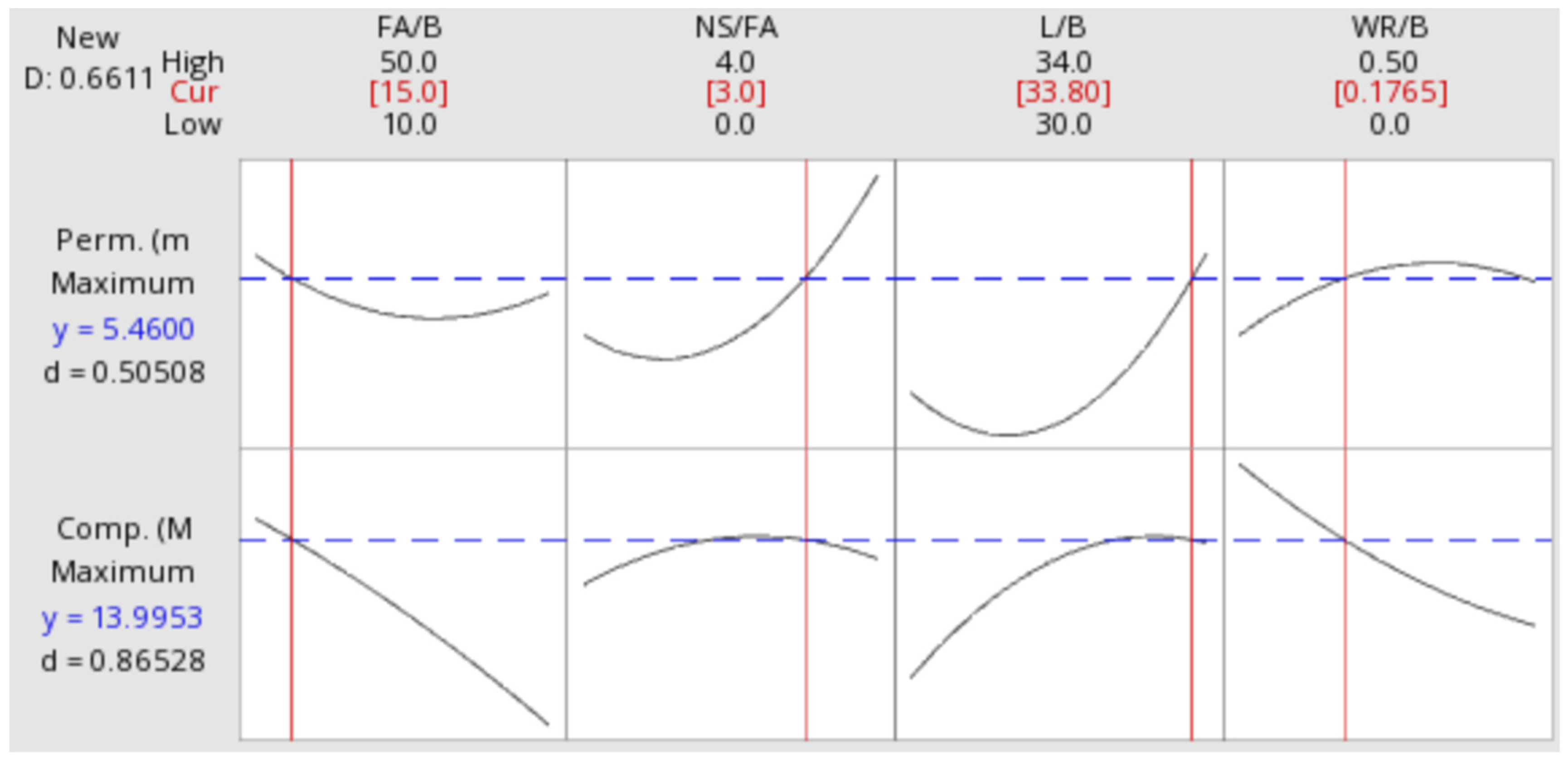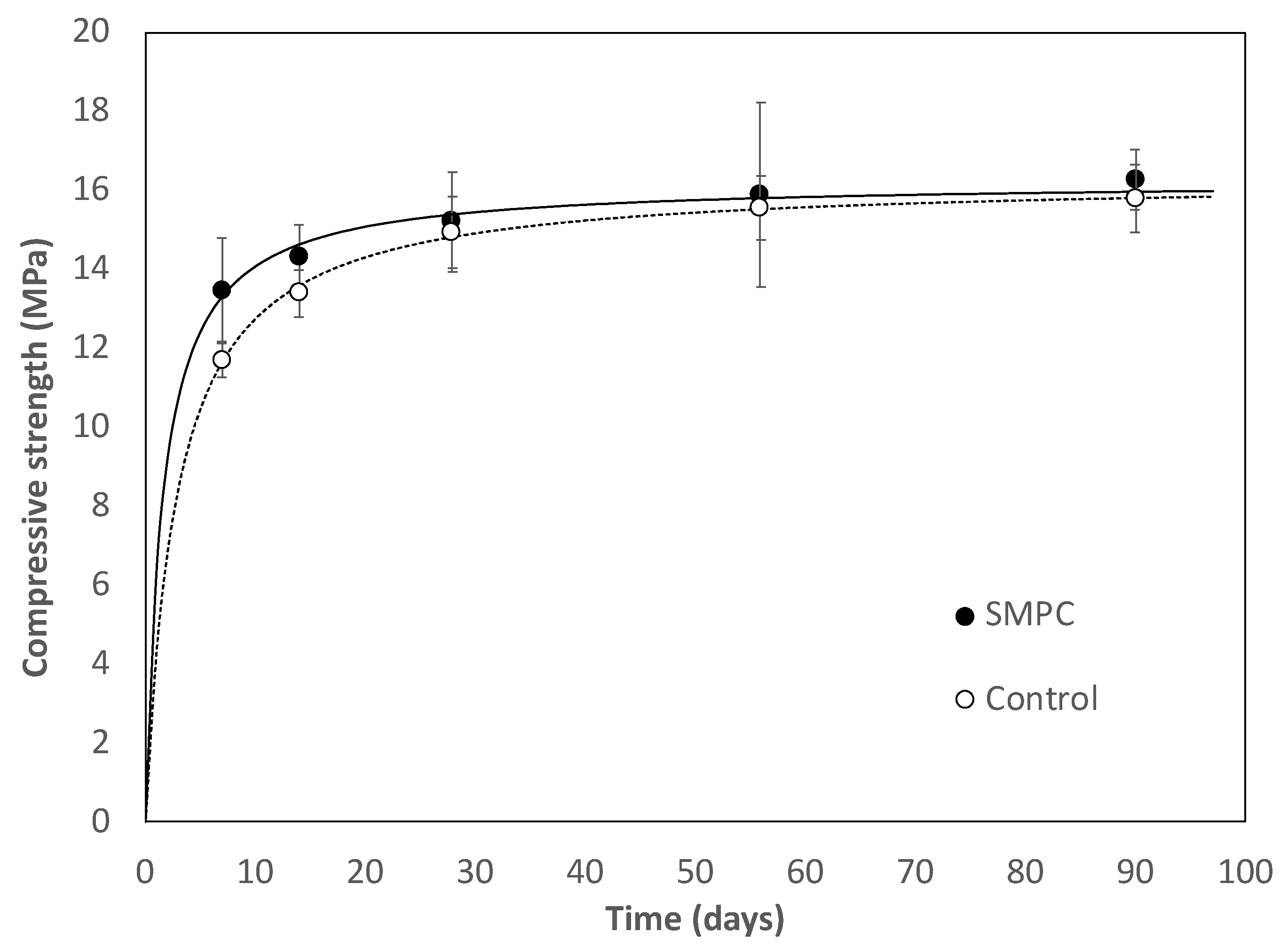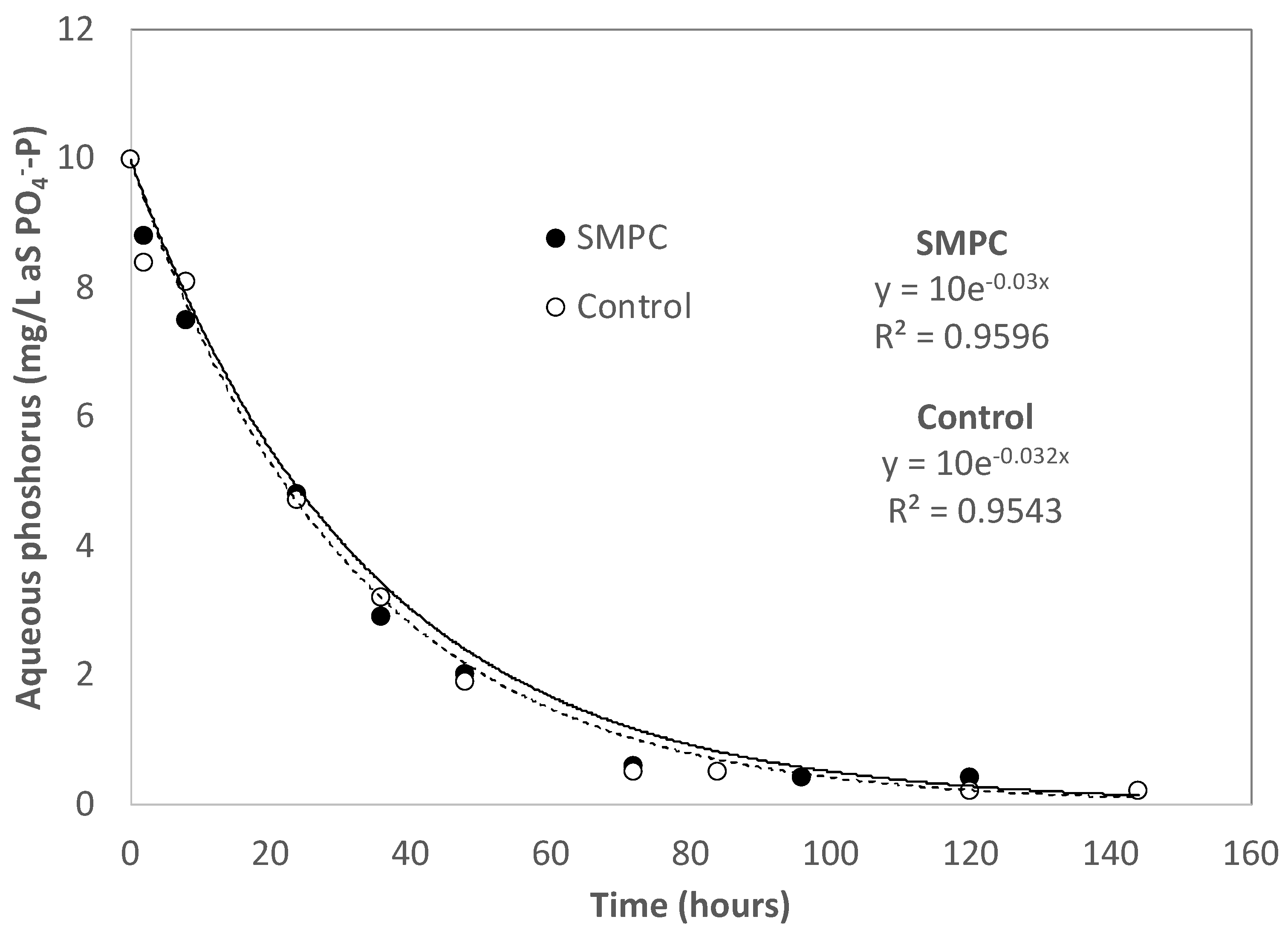Fly Ash-Added, Seawater-Mixed Pervious Concrete: Compressive Strength, Permeability, and Phosphorus Removal
Abstract
:1. Introduction
2. Materials and Methods
2.1. Main Materials
2.2. SMPC Mix Optimization
2.3. Aqueous Phosphorus Removal
2.4. Water Quality Analysis
2.5. Compressive Strength and Permeability of Pervious Concrete
3. Results and Discussion
3.1. Optimized SMPC
3.2. Long-Term Compressive Strength
3.3. Rate of Aqueous P Removal
3.4. Isotherm of Aqueous P Removal
4. Conclusions
- This study demonstrated a cleaner production of pervious concrete with seawater as a mixing water and an off-spec FA as a partial cement replacement to simultaneously attain water, waste, and concrete sustainability;
- The permeability of SMPC specimens ranged from 1.98 to 8.87 mm/s with the maximum compressive strength of ~16 MPa, which was found to be practically acceptable;
- The optimized SMPC had a slightly greater compressive strength at the early ages than the Control PC;
- For both SMPC and Control PC, aqueous phosphorus concentrations were dramatically decreased by 90% after 72 h of contact time, indicating that SMPC showed a plausible potential to improve water quality as a green infrastructure to manage stormwater runoff;
- Future studies are warranted to elucidate the mechanisms of aqueous P removal by FA-added, seawater-mixed pervious concrete, to test other waters including intermediate or reject seawater from desalination processes, and to understand the effect and fate of the constituents of concern in seawater such as microplastics.
Author Contributions
Funding
Institutional Review Board Statement
Informed Consent Statement
Data Availability Statement
Conflicts of Interest
References
- Li, L.G.; Feng, J.-J.; Zhu, J.; Chu, S.-H.; Kwan, A.K.H. Pervious concrete: Effects of porosity on permeability and strength. Mag. Concr. Res. 2021, 73, 69–79. [Google Scholar] [CrossRef]
- López-Carrasquillo, V.; Hwang, S. Comparative assessment of pervious concrete mixtures containing fly ash and nanomaterials for compressive strength, physical durability, permeability, water quality performance and production cost. Constr. Build. Mater. 2017, 139, 148–158. [Google Scholar] [CrossRef]
- Hwang, V.; Masters, A.; Arocho, M.; Hwang, S. Fly ash-amended pervious concrete pavement followed by bamboo bioretention basin with Dracaena sanderiana for urban stormwater runoff control. Constr. Build. Mater. 2017, 132, 161–169. [Google Scholar] [CrossRef]
- Sabnis, G.M. Green Building with Concrete: Sustainable Design and Construction, 1st ed.; CRC Press: Boca Raton, FL, USA, 2011. [Google Scholar]
- IEA. Global Cement Production, 2010–2019; International Energy Agency: Paris, France, 2020; Available online: https://www.iea.org/data-and-statistics/charts/global-cement-production-2010–2019 (accessed on 10 June 2021).
- Hanus, M.J.; Harris, A.T. Nanotechnology innovations for the construction industry. Prog. Mater. Sci. 2013, 58, 1056–1102. [Google Scholar] [CrossRef]
- Rehan, R.; Nehdi, M. Carbon dioxide emissions and climate change: Policy implications for the cement industry. Environ. Sci. Policy 2005, 8, 105–114. [Google Scholar] [CrossRef]
- Yao, Z.; Ji, X.; Sarker, P.; Tang, J.; Ge, L.; Xia, M.; Xi, Y. A comprehensive review on the applications of coal fly ash. Earth-Science Rev. 2015, 141, 105–121. [Google Scholar] [CrossRef] [Green Version]
- Chu, S.; Ye, H.; Huang, L.; Li, L. Carbon fiber reinforced geopolymer (FRG) mix design based on liquid film thickness. Constr. Build. Mater. 2021, 269, 121278. [Google Scholar] [CrossRef]
- Ilic, M.; Cheeseman, C.; Sollars, C.; Knight, J. Mineralogy and microstructure of sintered lignite coal fly ash☆. Fuel 2003, 82, 331–336. [Google Scholar] [CrossRef]
- Temimi, M.; Camps, J.; Laquerbe, M. Valorization of fly ash in the cold stabilization of clay materials. Resour. Conserv. Recycl. 1995, 15, 219–234. [Google Scholar] [CrossRef]
- Islam, G.M.S.; Rahman, M.; Kazi, N. Waste glass powder as partial replacement of cement for sustainable concrete practice. Int. J. Sustain. Built Environ. 2017, 6, 37–44. [Google Scholar] [CrossRef] [Green Version]
- Zaetang, Y.; Wongsa, A.; Sata, V.; Chindaprasirt, P. Use of coal ash as geopolymer binder and coarse aggregate in pervious concrete. Constr. Build. Mater. 2015, 96, 289–295. [Google Scholar] [CrossRef]
- Deschner, F.; Winnefeld, F.; Lothenbach, B.; Seufert, S.; Schwesig, P.; Dittrich, S.; Goetz-Neunhoeffer, F.; Neubauer, J. Hydration of Portland cement with high replacement by siliceous fly ash. Cem. Concr. Res. 2012, 42, 1389–1400. [Google Scholar] [CrossRef]
- Donatello, S.; Palomo, A.; Jimenez, A.M.F. Durability of very high volume fly ash cement pastes and mortars in aggressive solutions. Cem. Concr. Compos. 2013, 38, 12–20. [Google Scholar] [CrossRef]
- Güneyisi, E.; Gesoglu, M.; Algın, Z.; Mermerdaş, K. Optimization of concrete mixture with hybrid blends of metakaolin and fly ash using response surface method. Compos. Part B Eng. 2014, 60, 707–715. [Google Scholar] [CrossRef]
- Zeng, Q.; Li, K.; Fen-Chong, T.; Dangla, P. Determination of cement hydration and pozzolanic reaction extents for fly-ash cement pastes. Constr. Build. Mater. 2012, 27, 560–569. [Google Scholar] [CrossRef]
- Bhatt, A.; Priyadarshini, S.; Mohanakrishnan, A.A.; Abri, A.; Sattler, M.; Techapaphawit, S. Physical, chemical, and geotechnical properties of coal fly ash: A global review. Case Stud. Constr. Mater. 2019, 11, e00263. [Google Scholar] [CrossRef]
- Heebink, L.; Buckley, T.; Pflughoeft-Hassett, D.; Hassett, D. A Review of Literature Related to the Use of Spray Dryer Absorber Material. Production, Characterization, Utilization Applications, Barriers, and Recommendations. Tech. Rep. 1014915; Electric Power Research Institute: Washington, DC, USA, 2007. [Google Scholar]
- Kovler, K.; Wang, F.; Muravin, B. Testing of concrete by rebound method: Leeb versus Schmidt hammers. Mater. Struct. 2018, 51, 138. [Google Scholar] [CrossRef]
- Xiao, J.; Qiang, C.; Nanni, A.; Zhang, K. Use of sea-sand and seawater in concrete construction: Current status and future opportunities. Constr. Build. Mater. 2017, 155, 1101–1111. [Google Scholar] [CrossRef]
- Younis, A.; Ebead, U.; Suraneni, P.; Nanni, A. Fresh and hardened properties of seawater-mixed concrete. Constr. Build. Mater. 2018, 190, 276–286. [Google Scholar] [CrossRef]
- Ebead, U.; Lau, D.; Lollini, F.; Nanni, A.; Suraneni, P.; Yu, T. A review of recent advances in the science and technology of seawater-mixed concrete. Cem. Concr. Res. 2021, 152, 106666. [Google Scholar] [CrossRef]
- Liu, J.; Fan, X.; Liu, J.; Jin, H.; Zhu, J.; Liu, W. Investigation on mechanical and micro properties of concrete incorporating seawater and sea sand in carbonized environment. Constr. Build. Mater. 2021, 307, 124986. [Google Scholar] [CrossRef]
- Kaushik, S.; Islam, S. Suitability of sea water for mixing structural concrete exposed to a marine environment. Cem. Concr. Compos. 1995, 17, 177–185. [Google Scholar] [CrossRef]
- Pasupathy, K.; Sanjayan, J.; Rajeev, P.; Law, D.W. The effect of chloride ingress in reinforced geopolymer concrete exposed in the marine environment. J. Build. Eng. 2021, 39, 102281. [Google Scholar] [CrossRef]
- Li, L.; Chen, X.; Chu, S.; Ouyang, Y.; Kwan, A. Seawater cement paste: Effects of seawater and roles of water film thickness and superplasticizer dosage. Constr. Build. Mater. 2019, 229, 116862. [Google Scholar] [CrossRef]
- Dasar, A.; Patah, D.; Hamada, H.; Sagawa, Y.; Yamamoto, D. Applicability of seawater as a mixing and curing agent in 4-year-old concrete. Constr. Build. Mater. 2020, 259, 119692. [Google Scholar] [CrossRef]
- Yang, Y.-Y.; Toor, G.S. Stormwater runoff driven phosphorus transport in an urban residential catchment: Implications for protecting water quality in urban watersheds. Sci. Rep. 2018, 8, 11681. [Google Scholar] [CrossRef] [PubMed]
- Gunes, K. Point and nonpoint sources of nutrients to lakes—Ecotechnological measures and mitigation methodologies—Case study. Ecol. Eng. 2008, 34, 116–126. [Google Scholar] [CrossRef]
- ASTM International. ASTM C618: Standard Specification for Coal Fly Ash and Raw or Calcined Natural Pozzolan for Use in Concrete; American Society for Testing and Materials: West Conshohocken, PA, USA, 2016. [Google Scholar]
- ASTM International. ASTM C114: Standard Test Methods for Chemical Analysis of Hydraulic Cement; American Society for Testing and Materials: West Conshohocken, PA, USA, 2016. [Google Scholar]
- ASTM International. ASTM C204: Standard Test Method for Fineness of Hydraulic Cement by Air Permeability Apparatus; American Society for Testing and Materials: West Conshohocken, PA, USA, 2016. [Google Scholar]
- ASTM International. ASTM C430: Standard Test Method for Fineness of Hydraulic Cement by the 45-μm (No. 325) Sieve; American Society for Testing and Materials: West Conshohocken, PA, USA, 2016. [Google Scholar]
- ACI. American Concrete Institute Committee 522. Report on Pervious Concrete, 1st ed.; ACI 522R-10; American Concrete Institute: Farmington Hills, MI, USA, 2010. [Google Scholar]
- Koehler, E.; Offenberg, M.; Malone, J.; Jeknavorian, A.A. Chemical Admixture System for Pervious Concrete; American Concrete Institute Special Publication 262-20; American Concrete Institute: Farmington Hills, MI, USA, 2009. [Google Scholar]
- Li, G. Properties of high-volume fly ash concrete incorporating nano-SiO2. Cem. Concr. Res. 2004, 34, 1043–1049. [Google Scholar] [CrossRef]
- Soto-Pérez, L.; Hwang, S. Mix design and pollution control potential of pervious concrete with non-compliant waste fly ash. J. Environ. Manag. 2016, 176, 112–118. [Google Scholar] [CrossRef]
- Vázquez-Rivera, N.I.; Soto-Pérez, L.; John, J.N.S.; Molina-Bas, O.I.; Hwang, S.S. Optimization of pervious concrete containing fly ash and iron oxide nanoparticles and its application for phosphorus removal. Constr. Build. Mater. 2015, 93, 22–28. [Google Scholar] [CrossRef] [Green Version]
- ASTM International. ASTM C192: Standard Practice for Making and Curing Concrete Test Specimens in the Laboratory; American Society for Testing and Materials: West Conshohocken, PA, USA, 2016. [Google Scholar]
- ASTM International. ASTM C39: Standard Test Method for Compressive Strength of Cylindrical Concrete Specimens; American Society for Testing Materials: West Conshohocken, PA, USA, 2016. [Google Scholar]
- ASTM International. ASTM D2434: Standard Test Method for Permeability of Granular Soils; American Society for Testing and Materials: West Conshohocken, PA, USA, 2016. [Google Scholar]
- Gayathiri, K.; Praveenkumar, S. Influence of Nano Silica on Fresh and Hardened Properties of Cement-based Materials—A Review. Silicon 2022, 1–31. [Google Scholar] [CrossRef]
- Wang, X.; Chen, J.; Kong, Y.; Shi, X. Sequestration of phosphorus from wastewater by cement-based or alternative cementitious materials. Water Res. 2014, 62, 88–96. [Google Scholar] [CrossRef] [PubMed]
- Wu, F.; Yu, Q.; Gauvin, F.; Brouwers, H.; Liu, C. Phosphorus removal from aqueous solutions by adsorptive concrete aggregates. J. Clean. Prod. 2021, 278, 123933. [Google Scholar] [CrossRef]




| Properties | Portland Cement | Off-Spec FA |
|---|---|---|
| Mineralogical composition (% wt.) | ||
| SiO2 | 19.8 | 30.8 |
| Al2O3 | 5.1 | 9.9 |
| Fe2O3 | 3.1 | 5.0 |
| CaO | 67.3 | 39.6 |
| MgO | 0.8 | 0.4 |
| K2O | - | 1.0 |
| Na2O | - | 0.9 |
| SO3 | 2.7 | 11.4 |
| TiO2 | - | 0.5 |
| P2O5 | - | 0.1 |
| Loss-on-ignition (% wt.) a | 6.8 | 7.6 |
| Blane (m2/kg) b | 488 | 441 |
| Fineness (% wt.) c | 92.5 | 73.7 |
| Cl− | SO42− | Ca2+ | Mg2+ | K+ | Na+ |
|---|---|---|---|---|---|
| 18.6 | 2.1 | 4.4 | 1.1 | 0.4 | 4.3 |
| Compressive Strength (MPa) | ||
|---|---|---|
| 7-Day Curing | 28-Day Curing | |
| SMPC with 2% NS | 11.5 ± 0.3 | 13.8 ± 0.5 |
| SMPC without NS | 9.7 ± 0.2 | 12.4 ± 0.3 |
| Factors | Levels (% wt.) | ||||
|---|---|---|---|---|---|
| (−) Axial | Low | Center | High | (+) Axial | |
| Fly ash/binder a | 10 | 20 | 30 | 40 | 50 |
| NS/fly ash | 0 | 1 | 2 | 3 | 4 |
| Liquid b/binder | 30 | 31 | 32 | 33 | 34 |
| Water reducer/binder | 0 | 0.13 | 0.25 | 0.38 | 0.50 |
| Gravel (kg) | Cement (kg) | FA (kg) | NS (kg) | Seawater (L) | Tapwater (L) | WR (L) | |
|---|---|---|---|---|---|---|---|
| SMPC b | 1590.0 | 336.1 | 59.6 | 1.8 | 133.6 | - | 0.7 |
| Control PC c | 1590.0 | 397.5 | - | - | - | 125.8 | 1.4 |
| Run # | Factors and Levels (% wt.) a | Responses b | ||||
|---|---|---|---|---|---|---|
| FA/B | NS/FA | Liquid/B | WR/B | Compressive Strength (MPa) | Permeability (mm/s) | |
| 1 | 30 | 2 | 32 | 0.25 | 14.2 ± 1.2 | 2.36 ± 0.87 |
| 2 | 40 | 1 | 33 | 0.38 | 11.2 ± 2.0 | 2.24 ± 1.08 |
| 3 | 20 | 3 | 31 | 0.13 | 12.1 ± 1.9 | 2.74 ± 0.90 |
| 4 | 20 | 3 | 33 | 0.38 | 12.3 ± 2.8 | 3.96 ± 1.35 |
| 5 | 30 | 2 | 32 | 0.25 | 11.1 ± 1.1 | 2.85 ± 0.70 |
| 6 | 40 | 1 | 31 | 0.13 | 12.1 ± 1.4 | 5.00 ± 1.66 |
| 7 | 40 | 3 | 33 | 0.13 | 12.7 ± 4.0 | 3.52 ± 0.83 |
| 8 | 40 | 3 | 31 | 0.38 | 12.6 ± 1.1 | 3.27 ± 0.41 |
| 9 | 20 | 1 | 31 | 0.38 | 12.8 ± 0.7 | 2.77 ± 0.81 |
| 10 | 20 | 1 | 33 | 0.13 | 14.4 ± 1.6 | 2.69 ± 0.16 |
| 11 | 30 | 2 | 32 | 0.25 | 10.6 ± 0.4 | 2.11 ± 0.34 |
| 12 | 40 | 1 | 31 | 0.38 | 9.60 ± 1.0 | 5.82 ± 0.39 |
| 13 | 20 | 1 | 33 | 0.38 | 11.2 ± 2.0 | 3.13 ± 0.44 |
| 14 | 40 | 1 | 33 | 0.13 | 11.4 ± 0.5 | 3.39 ± 1.58 |
| 15 | 20 | 3 | 31 | 0.38 | 14.1 ± 2.0 | 2.40 ± 0.24 |
| 16 | 30 | 2 | 32 | 0.25 | 11.3 ± 1.2 | 4.24 ± 0.27 |
| 17 | 20 | 3 | 33 | 0.13 | 15.1 ± 2.2 | 2.62 ± 0.27 |
| 18 | 40 | 3 | 33 | 0.38 | 10.8 ± 1.8 | 3.50 ± 0.90 |
| 19 | 40 | 3 | 31 | 0.13 | 9.20 ± 2.4 | 5.82 ± 0.39 |
| 20 | 20 | 1 | 31 | 0.13 | 12.1 ± 1.9 | 1.98 ± 0.62 |
| 21 | 30 | 2 | 34 | 0.25 | 10.8 ± 1.8 | 5.23 ± 0.83 |
| 22 | 30 | 2 | 32 | 0.00 | 9.5 ± 1.2 | 6.59 ± 0.24 |
| 23 | 30 | 2 | 30 | 0.25 | 8.1 ± 1.1 | 8.87 ± 1.04 |
| 24 | 10 | 2 | 32 | 0.25 | 14.1 ± 3.1 | 3.57 ± 1.61 |
| 25 | 50 | 2 | 32 | 0.25 | 6.90 ± 1.1 | 8.70 ± 3.02 |
| 26 | 30 | 2 | 32 | 0.50 | 13.1 ± 2.8 | 3.00 ± 0.46 |
| 27 | 30 | 0 | 32 | 0.25 | 10.7 ± 0.7 | 6.91 ± 0.25 |
| 28 | 30 | 2 | 32 | 0.25 | 12.0 ± 1.7 | 4.40 ± 0.59 |
| 29 | 30 | 4 | 32 | 0.25 | 9.10 ± 1.0 | 6.76 ± 1.17 |
| 30 | 30 | 2 | 32 | 0.25 | 12.8 ± 1.5 | 5.66 ± 1.08 |
Publisher’s Note: MDPI stays neutral with regard to jurisdictional claims in published maps and institutional affiliations. |
© 2022 by the authors. Licensee MDPI, Basel, Switzerland. This article is an open access article distributed under the terms and conditions of the Creative Commons Attribution (CC BY) license (https://creativecommons.org/licenses/by/4.0/).
Share and Cite
Hwang, S.; Yeon, J.H. Fly Ash-Added, Seawater-Mixed Pervious Concrete: Compressive Strength, Permeability, and Phosphorus Removal. Materials 2022, 15, 1407. https://doi.org/10.3390/ma15041407
Hwang S, Yeon JH. Fly Ash-Added, Seawater-Mixed Pervious Concrete: Compressive Strength, Permeability, and Phosphorus Removal. Materials. 2022; 15(4):1407. https://doi.org/10.3390/ma15041407
Chicago/Turabian StyleHwang, Sangchul, and Jung Heum Yeon. 2022. "Fly Ash-Added, Seawater-Mixed Pervious Concrete: Compressive Strength, Permeability, and Phosphorus Removal" Materials 15, no. 4: 1407. https://doi.org/10.3390/ma15041407
APA StyleHwang, S., & Yeon, J. H. (2022). Fly Ash-Added, Seawater-Mixed Pervious Concrete: Compressive Strength, Permeability, and Phosphorus Removal. Materials, 15(4), 1407. https://doi.org/10.3390/ma15041407





